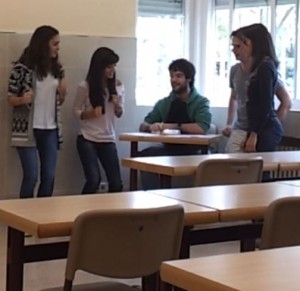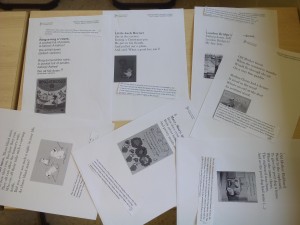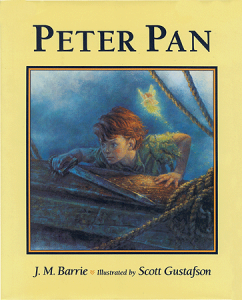Hi everyone! Welcome again!
Today I would like to devote this entry to talk about a topic which I consider is quite interesting, “Subversive messages hidden under infant literature”. It came up a few days ago, in our lesson focused on Nursery rhymes. The lesson was divided into three stages. The first one was a kind of introductory stage. Raquel made us builders of our own knowledge using different techniques to discover what Nursery Rhymes are, its origin and which elements characterise it. Some of those techniques were: analysing typical nursery rhymes, such as Humpty Dumpty, and carrying out a “dictogloss”. Throughout the last stage we had so much fun dramatizing different types of choral reading with Nursery rhymes as the “Solo lines” (one by one).
Dramatizing “Little Jack Horner”
Although during the introductory stage, we dealt with the topic a little bit (Nursery rhymes were originally created to hide political subversive messages), it was at the 2nd stage when we could be fully aware of what hidden subversive messages meant, through real examples. In other words, real Nursery Rhymes and the concrete hidden message that was under each of them. One example of it was the Nursery Rhyme named “Mary, Mary, quite contrary”. Its main character, although children don’t know it and most of us either, is the daughter of Henry the 8th, and some of the objects which appear refer to instruments of torture.
Nursery Rhymes and the concrete hidden message that was under each of them.
It piques my curiosity, so I decided to investigate which was the situation of the topic nowadays. Understanding subversive books as those which awaken our rebel side, something that surprises me, was the number of authors that are in favour of these kinds of infant literary books.
A staunch supporter of them, and detractor of those which she considers “contain what adults have decided [children] have to know” (1998) is Alison Lurie. Her opinion is faithfully reflected in the title of her work Don’t tell the grown-ups. According to the writer Lucy Fuchs (1984), the appeal of these works lies in the fact that “they discuss problems that are foremost in many children’s minds and that they often feel they cannot discuss with their parents”. There are also Spanish writers who support this kind of books, as the Mexican Jaime Alfonso Sandoval. He argues that subversive books are necessary due to the fact that they “allow children in a way to expose their thoughts or fears in a symbolic way” as well as to know “the real world they will have to face” (Sandoval cited by Wences, 2008).
What do you think about it? If you don’t know it, I think it would be appropriate to devote a little bit of time to reflect on it, due to the fact that as teachers we will be one of the most influential person in our pupil’s literary life.
Some of the titles that the previously mentioned authors present as “subversives”
Lurie, A. (1998). Don’t tell the grown-ups: the subversive power of children’s literature. Little, Brown.
Fuchs, L. (1984). The Hidden Messages in Children’s Books.
Wences, M. (2008, 15 June). Los libros infantiles deben ser subversivos, asegura Jaime Alfonso Sandoval. La Jornada Guerrero. Recovered from: http://www.lajornadaguerrero.com.mx/2008/06/15/index.php?section=cultura&article=013n2cul




Hello Azu!
Subversive messages hidden under infant literature is a great topic to talk about! It was so interesting when Raquel told us the real meaning about each story and that is something that we can check in many of the classic tales. I was doing a little research of the two books that you mention, Alice’s Adventures in Wonderland and Peter Pan, and it is true, there are more things under the simple story that we read. Most of the writers express their feelings; thoughts; political, religious or sexual tendencies; life experiences; likes and dislikes; their traumas or fear and they hid it in the story making it a perfect tale for children.
Hi Azu!
As Lidia said before, I also think the subversive messages hidden under infant literature is a great topic to work with because there is something that opens our thoughts about infant literature.
When Raquel give us the texts you mentioned in the post I was impressed about the idea that texts we can give to our future students to learn how to read, can be full of political or religious thoughts, and we didn’t know it. And that’s something we have to take into account.
Although, I think that maybe we have to use the texts only with the function of being a text, without focus on hidden messages that our students (and also us) couldn’t recognise.
So, I think this topic can be so wide and we have to speak a lot about how we want to use the texts: as a way of learning or as a way of reflecting.
Excellent post and nice comments. This discussion may lead us to think about subversive messages in other media. For example, what type of hidden messages can be found in trendy pop songs or TV ads? Give it a thought, it is worth the effort.